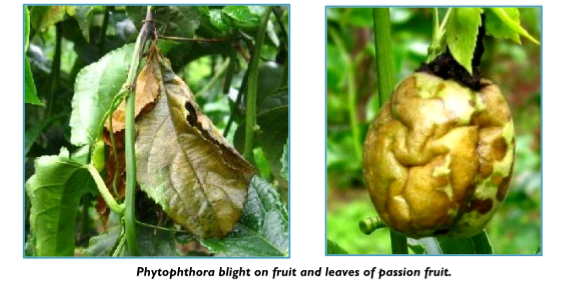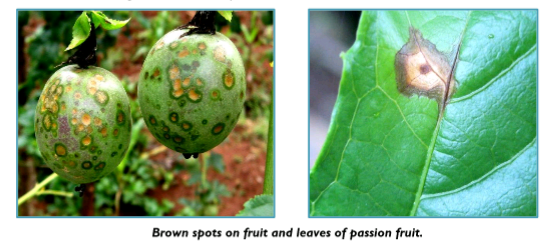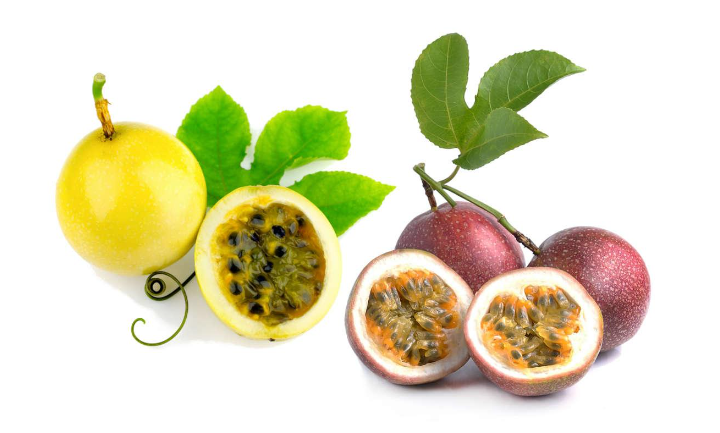
Passion fruit belongs to the family pasifloraceae. It is a flowering tropical vine, known as Passiflora. Passion fruits trees produce round or oval fruits which can be yellow, red, purple, and green in colour. The fruits have a juicy edible center composed of a large number of seeds. The part of the fruit that is used or eaten is the pulpy juicy seeds. Passion fruits can also be squeezed to make juice.
Passion fruit tastes sweet and tart. It has flavor that tastes like mandarin, orange, and pineapple. The fruit has a distinct smell.
Passion fruit growing has economic potential of alleviating poverty by creating employment along the value chain through production, processing, transportation and input supply system.
There are four species of passion fruit that are of economic importance. They are:
–Passiflora edulis var edulis (purple passion fruit) , – Passiflora edulis var flavicarpa (yellow passion fruit) ,
–Passiflora ligularis (sweet granadilla),
–Passiflora quandrangularis (giant granadilla)
–Passiflora incata.
The first four have edible fruits. The last is valued more as ornamental.
USES OF PASSION FRUIT
1. It has medicinal properties. The juice fight against cancer and reduce high blood pressure.
2. It is rich in soluble sugars
3. It contain vitamins A, C and ribloflavin. The vitamin A is important for skin, vision, and the immune system, and vitamin C, is an important antioxidant. They are also rich in polyphenols, and some contain prunasin and other cyanogenic glycosides in the peel and juice.
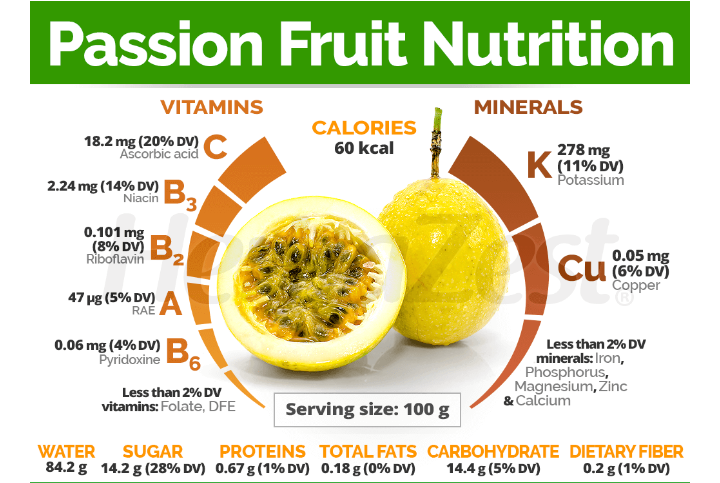
4. It is used as flavour in ice creams and sharvett
5. It can be processed into concentrates
6. The fruits can be slashed, dried and processed into tea
7. The fruit can be processed into jellys
8. It contains essential oil used in confectionery industries ( snack industry).
9. The shell can be dried and used as fodder
10. The undried shell can be used as silage.
11. It is highly rich in minerals and antioxidants. Antioxidants are compounds that help neutralize harmful free radicals in the body. It also play a vital role in keeping the body’s systems healthy. Antioxidants also improve blood flow, specifically to the brain and nervous system. They also reduce cellular stress and reduce inflammation in the body, both of which have links to diseases, such as heart disease and Alzheimer’s disease.
12. People can eat the seeds and pulp, juice them, or add them to other juices.
13. Passion fruit also contains phosphorus, niacin, and vitamin B-6, which are needed for healthy body.
14. Passion fruit pulp contains a lot of dietary fiber. Fiber is a crucial component that helps regulate the digestive system and keep the gut healthy, preventing constipation and bowel disorders. Fiber also has benefits in reducing cholesterol and boosting heart health.
15. Passion fruit has a low glycemic index (GI) value. This means that it does not cause a steep increase in blood sugar after eating it. This makes it a good option for people with diabetes.
16. The Vitamin C content in passion fruit helps boosts the immune system by helping the body absorb more iron from plant-based foods, and may improve the body’s ability to fight off infections in the body.
17. Passion fruit contains magnesium, which is an important mineral that linked with decreased in stress and anxiety. Research has reported that magnesium can help people manage their anxiety levels.
18. Latex contains some proteins similar to those in passion fruit. People with a latex allergy may react to passion fruit. This is called cross-reactivity.
19. Research report that passion fruit can have a sedative effect and may be a good natural option to help a person having a hard time falling asleep.
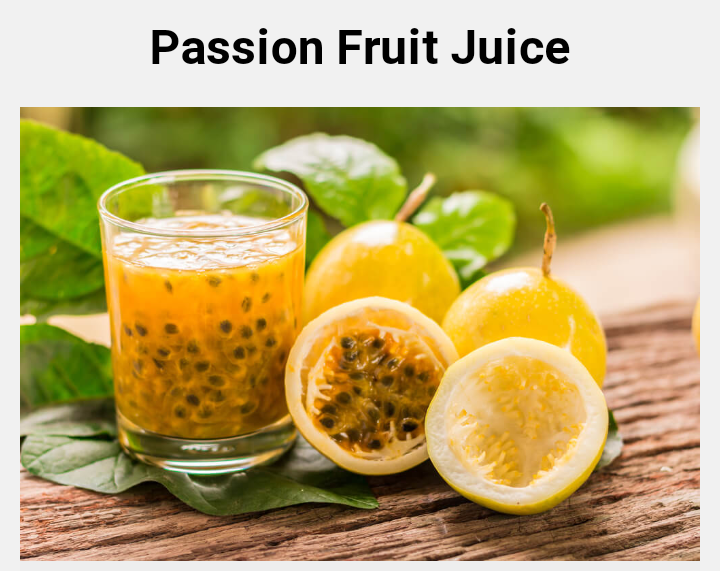
Passion fruit peel flour contains pectin, a soluble fiber that can reduce cholesterol levels. It is also good in livestock diet. It can be fed to a variety of livestock, including: Steers which can feed on fruit by-products, rabbits can feed on the fruit seed to improve their growth, heifers and milking cow can feed on the fresh fruit peel silage, and broilers can feed on the fruit seed.
Apart from the benefits passion fruit offers to human, it can also be fed to livestock because it’s a good source of nutrients and can improve animal health. Some of the benefits of passion fruit as livestock feed include;
20. DIGESTIBILITY: Passion fruit by-products are highly digestible, which can improve weight gain. It is rich in dietary fiber, which eases the digestion process. It also has a high water content, which is important for digestion in livestock.
21. CARCASS TRAITS; Passion fruit seed can improve carcass traits and meat quality in rabbits. Rabbit meat for example has high level of polyunsaturated fatty acids which result in oxidative damage during the meat storage. Passion fruit seed (PFS) has a large amount of phenolic compounds. This is a compound that can help reduce oxidative damage during storage of rabbit meat. Therefore, rabbit diet containing PFS will help the rabbit to grow, and increase the shelf life of rabbit meat.
22. ANTIOXIDANTS: Passion fruit contains many antioxidant compounds such as vitamins C, flavonoids and polyphenols, which can improve antioxidant status in animals. It is also a good source of vitamin C, which is an important antioxidant. Vitamin A, which is important for the immune system, vision, and skin. And it also contains fiber, which is good for a healthy body.These compounds can help neutralize harmful free radicals in the body.
23. ESSENTIAL FATTY ACIDS; Passion fruit seeds contain essential fatty acids like linoleic acid, oleic acid, and palmitic acid. Passion fruit seed meal (PFSM), a co-product of passion fruit processing for juice, which is a potential feed ingredient contains essential oil. A study carried in 2004 reveals that extracted PFSM contains 12.4% carbohydrates (~9.5% in full fat PFSM). This contain high oil content that makes it an energy source which can be used in diets for layers, breeders, sows, and ruminants.
24. FIBER : Passion fruit pulp contains dietary fiber, which can help with digestion and gut health. By improving digestion, the animal performance and carcass traits will also be improved in turn.
25. GUT FUNCTION: Passion fruit peel (PFP) can improve gut function by reducing inflammation and increasing short-chain fatty acids. The PFP intake can maintain intestinal barrier by increasing mucins expression, reducing metalloproteinases (MMPs) expression and promote short-chain fatty acids (SCFAs) production. These positive effects may be attributed to dietary fiber and polyphenols in PFP. This gives reasons why passion fruit is beneficial to gut health and might be a promoter for the growth of broilers
26. CHOLESTEROL: The intake of fiber mesocarp passion fruit, lowers the level of triglyceride and cholesterol decreasing principally insuline and leptin etc.
ORIGIN OF PASSION FRUIT : Passion fruit originate from Brazil. It is now grown all over the world including Nigeria. But large importation to Nigeria is from South Africa.
PROPAGATION OF PASSION FRUIT : Most popular method of propagating passion fruit is by seed. It is also propagated vegetatively by cutting and grafting.
Purple passion fruit grow better under cool conditions. It is popular in Kenya and Burundi, especially at elevated areas. The yellow passion fruit is grown in lowland areas like Nigeria. It’s varieties include E-23, purple gold and noel etc.
PROPAGATION TIME: Purple passion fruits have strong flavour, while the yellow variety is more tolerant to pest and diseases. Because of this tolerance, it is used as a root stock. The yellow passion fruit is recommended in Nigeria because it requires no cold condition. During vegetative propagation through grafting, if care is not taken, self incompatibility may occur between the scion and the stock. This will lead to low yield. The yellow passion fruit stock are preferably grafted with the purple passion fruit vine scion.
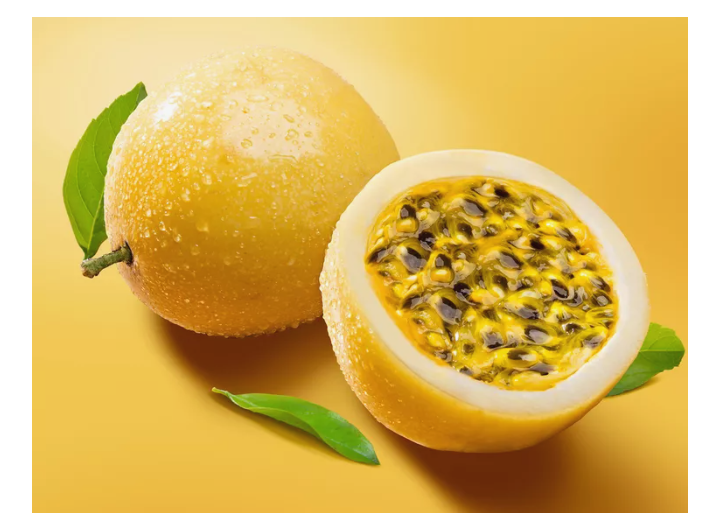
SEED EXTRACTION: The fruits should be washed and cut to extract the seeds. The seeds should be left to ferment in plastic or glass containers for 2 to 3 days. This fermentation helps to decompose the mucilage covering around the seed to enhance seed germination. The seeds are then washed and tested under floatation method to select the viable ones.
SEEDING: Viable seeds can be planted in intact soil. The seed should be selected using floatation method and scarified with sand. The seeds are planted in nursery in a seed box where they grow into seedlings. The seeds are planted in drills of about 9.5cm depht. By 2 to 3 weeks after planting, the germinating seedlings should be transplanted into the nursery polythene bags containing sterilized soil. The soil is sterilized to control root knot nematodes, soil borne diseases and other harmful organisms. After which the seedlings are transplanted to the field.
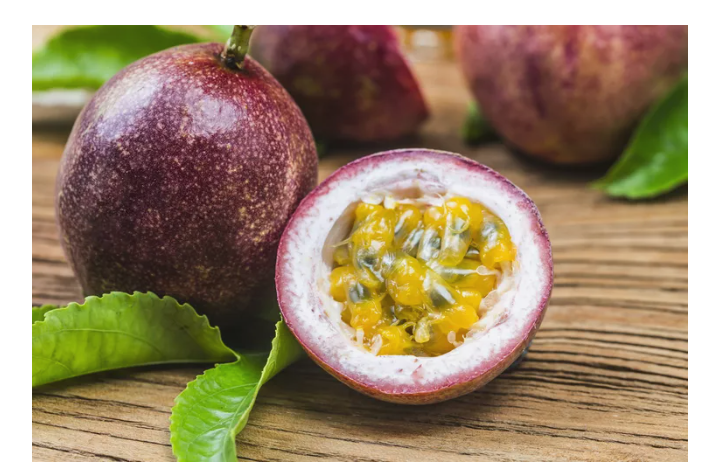
PLANTING SPACE: The field should be properly cleared of all vegetation. Afterwhich, the land is mapped out in coordinates of 3 by 4m, or 4 by 4m or 5 by 5m.
Note, that the population and leaf density do affect the yield and management practices in raising passion fruit.
SOIL REQUIREMENT : Deep, well drained and not acidic (pH 5.5 to 6.5) loamy soils are required. It requires rainfall of about 1200mm/annum.
Fruits can the planted from August through January and February. Nursery starts by January and by April, the seedlings are ready for transplanting
STAGES OF GERMINATION IN PASSION FRUITS
Passion fruits have three stages of growth which are: juvenile stage, transition stage and maturity stage.
TRAINING AND TRELLISING IN PASSION FRUIT
Passion fruit is a vine plant, therefore, it needs support and staking to make it grow properly. It needs training. The aim of training passion fruit vine is to get the vines on the wires of the trellis as quickly and as soon as possible. As the plants are growing, small stakes should be erected beside them to provide support for the young leaders. As the shoots are growing, the strongest two shoots should be selected and other weak ones pruned off to allow maximum growth among the leaders.
Before the two shoots attain a lenght of about 2m, trellis should be constructed to support the veins.
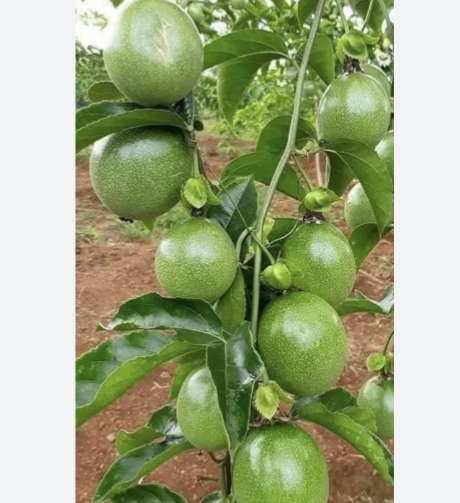
TYPES OF TRELLIS SUPPORT FOR PASSION FRUITS.
1. INTEGA ( LIKE A TABLE) : The intega trellis is constructed to take the shape of a table with four legs. The vines start creeping from the legs of the structure. The top can be made with long wooden materials laid from one side to another. Or wire or wire net can be used for the top. The vines then cover the top with the fruits drooped down but not touch the ground.
2. SIDE TRELLIS: This is the use of poles which are erected in the ground. The vines are rapped round the pole and wires are tied to hold the vine to the pole. The end of the wire is then held with a peg to hold it firm. When the plant grows to about 1m, the apex of the shoot is pinched and the branches should be allowed to spread on the wire. Pinch out the top bud is to encourage lots of side shoots development . Cut vines back after fruiting if too dense to encourage new laterals and more fruit.
3. VERTICAL FENCE STYLE TRELLIS: vertical fence-style trellis is made of a large stay posts at either end of a row and wooden posts strung with steel wire at the top level. The young plants are planted in line with the posts equidistant and trained up a wire or string to reach the top wire
Once a plant reaches the top wire, two opposing leaders are trained along the wire to provide the vine with support as it grows and begins to bear fruit
Alternative growing systems in use are overhead trellis, T-trellis and A-frames and double cross.
HARVESTING OF PASSION FRUIT: Newly planted passionfruit vines can take 12-18 months before they begin fruiting heavily. The crop matures within 9 months and can be harvested 3 to 4 times in a year depending on availability of rain and irrigation. Some varieties are ripe when they fall to the ground. Which are then pick up, wash and store. They can be stored for up to 2-3 weeks. Other varieties are picked when plump. Some people believe passion fruit are best ready for eaten when the skin are wrinkled, others believe the best time to eat it is when plump, heavy, and still firm. Passion fruits should not be eaten or avoided when any of part of the skin still has green spots.
LIFESPAN: The purple variety has a lifespan of between two and half years to three years. While the yellow variety has a lifespan of five years.
PEST AND DISEASES OF PASSION FRUIT
PEST: Pests of passionfruit include slugs and snails, sap-sucking insects such as passion vine hopper, scale and mealy bug, and fruit fly.

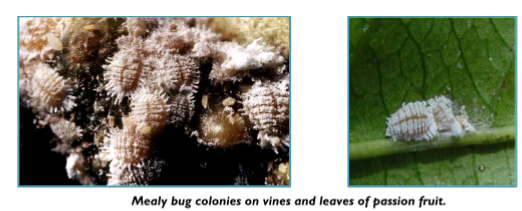
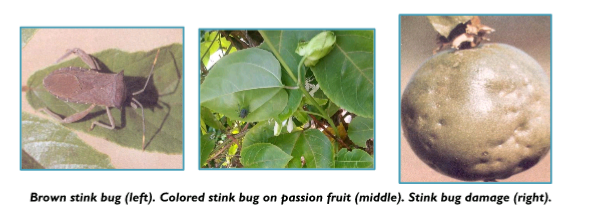
DISEASES: Diseases are few. Fungal diseases including brown spot and septoria (also a problem on tomato plants) and passionfruit woodiness virus are the main culprits.
